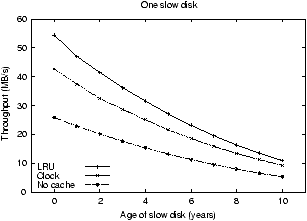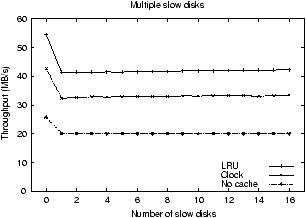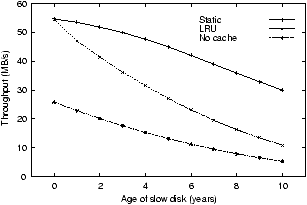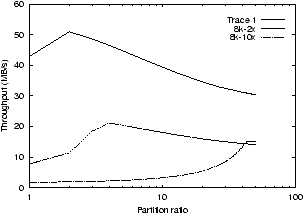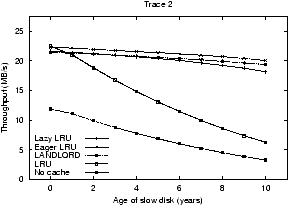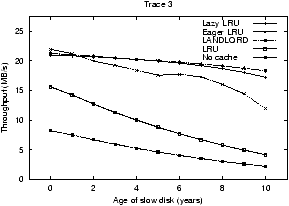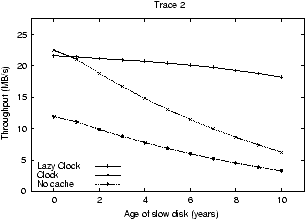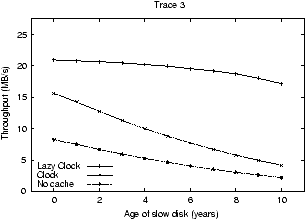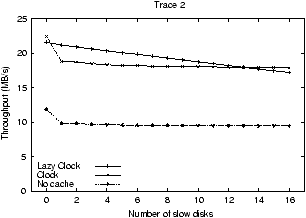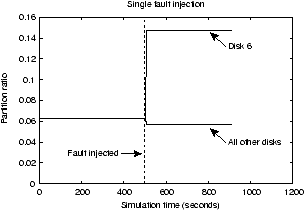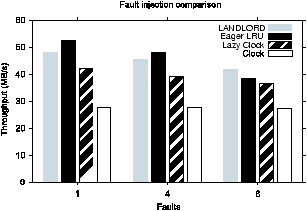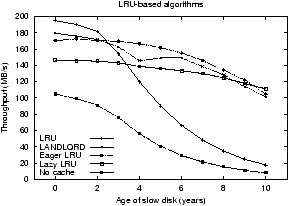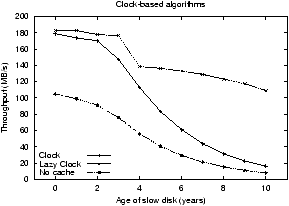|
FAST 2002 Paper
[FAST Tech Program Index]
| Pp. 61–74 of the Proceedings |  |
Storage-Aware Caching:
Revisiting Caching for Heterogeneous Storage Systems
Brian C. Forney Andrea C. Arpaci-Dusseau Remzi H. Arpaci-Dusseau
Computer Sciences Department
University of Wisconsin, Madison
{bforney,dusseau,remzi}@cs.wisc.edu
Abstract:
Modern storage environments are composed of a variety of
devices with different performance characteristics. In this paper,
we explore storage-aware caching algorithms, in which the file
buffer replacement algorithm explicitly accounts for differences in
performance across devices. We introduce a new family of
storage-aware caching algorithms that partition the cache, with one
partition per device. The algorithms set the partition sizes
dynamically to balance work across the devices. Through simulation,
we show that our storage-aware policies perform similarly to
LANDLORD, a cost-aware algorithm previously shown to perform well
in Web caching environments. We also demonstrate that partitions
can be easily incorporated into the Clock replacement algorithm,
thus increasing the likelihood of deploying cost-aware algorithms in
modern operating systems.
1 Introduction
Modern computer systems interact with a broad and diverse set of
storage devices, including local disks, remote file servers such as
NFS [30] and AFS [16], archival
storage on tapes, read-only media such as compact discs and DVDs, and
even storage sites that are accessible across the
Internet [4, 19, 25, 36].
As new storage components are
introduced [11, 31, 34],
their behaviors and properties will likely become even more divergent
than they are today.
Although this set of devices is disparate, one commonality pervades
them all: the time to access them is high, especially as compared to
CPU cache and memory latencies [23]. Due to the cost of
fetching blocks from storage media, caching of blocks in main
memory often reduces execution time of individual applications and
increases overall system performance -- often by orders of magnitude.
However, while storage technology has dramatically changed over the
past few decades, important aspects of the caching architectures used
by modern operating systems have remained unchanged. Though there have
been innovations in mechanism, including the integration of the file
cache and virtual memory page cache [21],
copy-on-write techniques [26], and software emulation of
reference bits [7], there has been little change in
policy, with most operating systems employing LRU or LRU-like
algorithms to decide which block to replace.
The problem with LRU and related caching algorithms is that they are
cost-oblivious: all blocks are treated as if they were fetched
from identically performing devices and can be re-fetched with the
same replacement cost as all other blocks. Unfortunately, this
assumption is increasingly problematic, as the manifold device types
described above have a correspondingly rich set of performance
characteristics. As a simple example, consider a block fetched from a
local disk as compared to one fetched from a remote, highly contended
file server; in this case, the operating system should most likely
prefer the block from the file server.
Within such heterogeneous environments, file systems require caching
algorithms that are aware of the different replacement costs
across file blocks. Given that the slowest device roughly determines
the throughput of the system, storage-aware caching seeks to balance
work across devices by adjusting the stream of block requests. Hence,
in a heterogeneous environment, a storage-aware cache
considers workload behavior and device characteristics to
filter requests.
Thus, in this paper, we explore the integration of cost-aware
algorithms into an operating system page cache using simulation. Our
simulation accounts for real-world factors such as an integrated page
cache and simplicity of design. We build on previous work in
cost-aware caching from the web-cache and theory communities,
demonstrating that a separate set of partitioned algorithms are as
effective, yet simpler, than proposals in those research areas.
Our study is set in the context of a network-attached disk system.
Network-attached disks are an increasingly important storage paradigm,
and present clients with both static and dynamic forms of performance
heterogeneity [5, 6, 13]. However, the algorithms we develop are
general and can be applied across a broader range of storage devices.
Our main results are as follows. We show storage-aware caching is
significantly more performance robust than cost-oblivious caching and
as robust as a leading web-caching algorithm. Since operating
systems have specific implementation needs, we develop and evaluate a
version of storage-aware caching that extends the commonly implemented
Clock algorithm.
The rest of this paper is organized as follows. In
Section 2 we give an overview of the algorithms
that we investigate in this paper. We then describe our algorithm for
selecting partition sizes in
Section 3.
Section 4 describes the assumptions of our
environment in more detail and explains our simulation framework.
Simulation results are in Section 5. We compare
and contrast our work to existing work in Section 6,
and Section 7 contains future work. Finally, we
conclude in Section 8.
2 Algorithm Overview
This section provides an overview of the algorithmic space we
explore. First, we describe existing cost-aware algorithms as a
basis of comparison. We then present our caching algorithms, which are
based upon partitioning the cache according to replacement cost.
2.1 Existing Cost-Aware Algorithms
The theoretical community has studied cost-aware algorithms as
k-server problems [12, 20]. A restricted class of k-server problems,
weighted caching, is closely related to cost-aware caching.
LANDLORD [40] is a significant
algorithm in the literature, which we use for comparison. LANDLORD
is closely related to the leading web caching
algorithm [10].
LANDLORD combines replacement cost, cache object size, and locality
by extending both LRU and FIFO to include cost and variable cache
object sizes within a cache. Since we configured LANDLORD to use
LRU, we describe the LRU version. LANDLORD associates a cost with
each object, which is called L. When an object enters the cache,
LANDLORD sets L to H, which is the retrieval cost of the object
divided by the size of the object. If object eviction is needed,
LANDLORD finds the object with the lowest L value, removes it, and
ages all of the remaining objects. LANDLORD ages pages by
decrementing the L value of all remaining objects by the L value
of the evicted object. Upon reference of an object in the cache,
LANDLORD restores its L value to H. LANDLORD degenerates to
strict LRU when all H values are the same.
LANDLORD has attractive theoretical and experimental properties.
As shown by theoretical analysis, when the size of cache objects are
the same, LANDLORD is k-competitive, where k is the size of the
cache. Thus, in a fixed object size cache, LANDLORD performs within
a factor of k of the optimal off-line algorithm over all possible
request sequences [39].
2.2 Overview of Aggregate Partitioned Algorithms
All of the cost-aware algorithms in the literature are place-anywhere.
A place-anywhere algorithm has two characteristics: blocks
may occupy any logical location in the cache, independent of
their original source or cost, and costs are recorded on a page
granularity. The advantage of place-anywhere algorithms is they
calculate, in a single value, the trade-off between locality and cost.
Thus, at replacement time, these algorithms bias eviction toward pages
with low retrieval cost.
In contrast to a place-anywhere algorithm, an aggregate
partitioned algorithm divides the cache into logical partitions,
where blocks within a logical partition are from the same device and
thus share the same replacement cost. The algorithm aggregates
replacement cost since it is a function of a device's performance. An
aggregate partitioned algorithm benefits from the aggregation of
blocks and cost metadata in two ways: the amount of metadata is
reduced and the value of the metadata more closely reflects the current
replacement cost of a block from a device. Thus, the space overhead is
proportional to the number of devices currently used and blocks are
more likely to be replaced when the replacement cost is low.
Conversely, place-anywhere algorithms only record the cost when the
page is brought into the cache. Thus, when the cache has a reasonably
large number of pages, as is common today, a place-anywhere algorithm
is more susceptible to inconsistent cost values. Aggregate
partitioned algorithms avoid this problem by aggregating cost
metadata on a per-device basis. As the performance of the device
changes, the cost metadata is rarely inconsistent for more
than a brief period of time. While a place-anywhere algorithm could
recognize the change in cost for a device, and propagate the new cost
to all pages in the cache, the cost update requires a significant
number of pages to be updated, increasing overhead and
implementation complexity.
Aggregate partitioned algorithms strive to set the relative size of
each partition to balance work across devices. We define work as balanced
when the cumulative delay for each device within a period of time
is equal. To balance work, the size of each partition reflects the
relative cost of those blocks in a simple and efficient manner. For
example, in a storage system with one slow disk and one fast
disk, the cache is divided into two partitions, with the slow disk
likely receiving a larger partition. We describe precisely how the
relative sizes should be configured in the next section.
To choose a victim block, a storage-aware algorithm first selects a victim
partition and then a victim block within that partition. The victim partition
is chosen such that its resulting size relative to other partitions maintains
the desired proportions. The individual victim within that partition can be
selected with any replacement algorithm, such as LRU, LFU, or FIFO.
A few distinctions to prior work in virtual memory systems should be noted.
Unified and partitioned virtual memory systems: In the
traditional sense, partitioned virtual memory systems distinguish
between file system pages and virtual memory pages. The two are
managed separately. Our storage-aware algorithms do not explicitly
distinguish between file system pages and virtual memory pages.
Rather, in order to balance work, our algorithms distinguish between
pages based on which device supplied the page. Additionally,
storage-aware caching algorithms change the size of partitions
dynamically. Most partitioned virtual memory systems do not change
the size of the file system cache and virtual memory partitions.
Local and global page replacement: Local page replacement at
eviction time considers processes in isolation, while global page
replacement applies replacement across processes. Our storage-aware
algorithms make per-partition replacement decisions, which is similar
to the traditional notion of local page replacement. However, the
decisions are based on cost and locality, not solely on
locality as in local page replacement schemes.
2.3 A Taxonomy of Aggregate Partitioned
Algorithms
In our work, we investigate a taxonomy of aggregate partitioned
algorithms and show that dynamic aggregate partitioning is needed. The
taxonomy is described in this subsection.
Two basic approaches are possible for aggregate partitioning:
static and dynamic. In a static scheme, the ratio
across partitions is selected once according to a one-time notion of
the costs. However, with no knowledge of the workload and its
resulting miss rates for a given cache size, one cannot a priori
determine the relative sizes that lead to balanced work. Thus, dynamic
partitioning is needed, in which the ratio of partition sizes
adjusts as the requests are monitored.
Dynamic partitioning have the following three benefits. First, dynamic
partitioning can adjust to the dynamic performance variations, or
faults, common in modern devices [6].
Second, dynamic partitioning can react to contention at devices due to
hotspots in workloads. Finally, dynamic partitioning can compensate for
the fact that the performance ratios across devices can change as a
function of the access patterns.
Dynamic partitioning can be divided into eager partitioning and
lazy partitioning. With eager partitioning, when new partition
sizes are desired, the algorithm immediately reallocates pages using
new cost information. An algorithm with a lazy partitioning scheme
gradually reallocates pages on demand to the desired size in response
to the workload. Eager partitioning simplifies choosing a victim
partition, since it is the same as the location of the new page, at
the cost of removing pages which may be useful. Conversely, a lazy
partitioning scheme only removes pages from partitions when they are
truly needed by another partition.
With lazy partitioning, a block may replace any other block, as long
as blocks are replaced at the proper frequency to maintain the desired
partition size ratios. Thus, on replacement, one must explicitly
choose a victim partition. We investigate a strategy based on an inverse lottery, as previously proposed for resource
allocation [33, 37]. The idea
is that each partition is given a number of tickets in inverse
proportion to its desired size. When a replacement is needed, a
lottery is held by selecting a random ticket; the partition holding
that ticket is picked as the victim. The victim then gives up its
least valuable page, and the lazy partitioning algorithm allocates the
page to a new logical partition.
3 Selecting Partition Sizes
The main challenge with partitioned approaches is in determining how
the relative sizes of the partitions should be configured.
Storage-aware caching can be viewed as performing selective filtering
of requests to devices. Assuming the slowest device limits the system
throughput, the goal of storage-aware caching is to set the partition
sizes such that an equal amount of work is sent to each device. More
formally, for each device, the number of cache misses multiplied by
the average cost of each miss should be equal.
3.1 Algorithmic Details
Our basic approach uses a dynamic repartitioning algorithm. In the
algorithm, the storage-aware cache observes the amount of work
performed by each device over a fixed interval in the past and
predicts how the relative sizes of the partitions should be adjusted
so that the work is equal. The algorithm's work metric is
cumulative delay over a period of time. The delay is related to the
total number of requests but includes request service time variation
within a device and between devices. In this algorithm, streaming
accesses that do not fit in the cache are problematic as the algorithm
does not currently detect this type of access.
Our algorithm measures the time spent waiting for each device over the
past W device requests, where W is the window size, and records
this as the wait time per device. If all of the wait times are
approximately equal, then the current partition ratios are deemed
adequate and they remain the same. If the wait times are not the
same, then the size of those partitions with relatively large wait
times should be increased, and the size of those partitions with
relatively small wait times should be decreased. Of course, the ratio
of the wait times across all devices should be considered
simultaneously.
Selecting the appropriate amount by which to increment and decrement
each partition is a non-trivial search problem, given that one does
not know how a given change in partition size affects the future miss
rate, especially in the presence of dynamically changing workloads.
Thus, with our initial approach, we employ the simplest algorithm that
we have found to meet our needs. The challenge is to find an
algorithm that adjusts partition sizes quickly enough to find the
right proportions, but not so quickly that the algorithm overshoots
those correct proportions.
To meet both of these goals simultaneously, our approach aggressively
increases the size of a partition when the wait time for the
corresponding device is increasing and otherwise reacts in a
conservative manner. As such, our algorithm makes observations about
the wait time for each device during an epoch, and an action is taken
based on the observation. A new epoch begins after W device requests
complete and between epochs the cache
is repartitioned.
Repartitioning occurs in four steps. First, the algorithm computes the
per-device wait time and the mean wait time across devices during the
epoch. Second, the algorithm computes a relative wait time
for each partition by dividing the per-device wait time by the mean
wait time. Next, the algorithm determines which partitions are
page consumers and how many pages to give each consumer.
Page consumers are partitions which have a relative wait time above a
threshold T. A threshold is used to filter normal variations in the
wait time not due to changes in workload or device characteristics. If
no page consumers are found, repartitioning stops and the new epoch
begins. Finally, the algorithm finds partitions with below-average
wait times, called page suppliers, and reallocates
pages from them to consumers until the consumers reach their desired
size.
While repartitioning the cache, the algorithm classifies each
partition into one of four states, and may take corrective action to
change the partition size. The four states are shown in
Figure 1 and are described as follows.
Figure 1:
Corrective actions taken by our repartitioning
algorithm. This figure shows the four actions taken by our
algorithm in response to four states. The graph shows the
observation of the per-device wait time trend relative to the mean
wait time as time progresses. A dotted line shows the mean wait
time in each graph. Below the graphs are the actions taken in each
state. While shown as fixed for overall clarity, the threshold is
a constant value multiplied by the mean wait time.
-
Cool: wait time below the threshold.
The wait time is within the normal operating regime. No
corrective action is needed. Some cool partitions may
become page suppliers, but none become page consumers.
- Warming: wait time above threshold and increasing.
The algorithm infers an increasing wait time is due to changes in
the workload or the device characteristics. Initially, the cache
size is increased by I pages, where I is the base
correction amount. If a partition continues to warm in subsequent
epochs, the increase in cache size grows exponentially. A
reclassification of a partition as warming from any other state
restarts exponential correction.
- Cooling: wait time above threshold and
decreasing. Corrective action during a set of epochs may have
halted the increase in wait time for a partition and started a
decline in wait time. The algorithm acts conservatively in the
cooling state and does not change the partition size. A more
aggressive approach that continues to increase the cache size for
this state may over-correct and become unstable.
- Warm: wait time above threshold and constant. Based on
experimental evidence, partitions are most often classified as cool,
warming, or cooling. Thus, a constant wait time is unlikely to
occur, and the partition moves to another state with a small change in
the partition size. Thus, the algorithm increases the partition
size by I.
The last step of the algorithm reallocates pages from page suppliers
to page consumers. The algorithm biases collection of pages toward
partitions that have the lowest relative wait times. To determine the
number of pages removed from each page supplier, the algorithm first
computes the inverse relative wait time (IRWT), which is
just 1 - relative wait time, for each partition. Next, it sums the
inverse relative wait times. Finally, the number of pages a
partition j must supply is computed:
IRWTj/sum of IRWTs for suppliers * # of consumed pages
Note that there are three parameters to this algorithm: window size
(W), threshold (T), and base increment amount (I). Each needs to
be set with care. The value of W should be large to smooth out wait
time variations and to sample a sufficient number of requests to
determine accurately the effect of corrections. We have found W=1000
provides sufficient smoothing and feedback. The value of I should be
small since exponential correction is taken. We have found a value of
0.2% of the cache works well in practice. The threshold value, T,
should be large enough to filter normal device performance fluctuation
such as seek time. We have found T=5 detects changes in wait time
that warrant correction. Rather than use a fixed value of T, the
algorithm could compute the threshold dynamically as the statistical
variance of wait times and use the sum of the mean and the variance as
the threshold. We do not discuss this adaptive approach here, but we
plan to investigate it in the future.
3.2 Modifying Existing Replacement Algorithms
Not only do we desire to have a cost-aware cache that performs well,
but also one that can be easily implemented in modern operating
systems. Although attention has been paid to make it computationally
efficient, LANDLORD needs a priority queue to efficiently find the
lowest cost object and its use of L does not mesh well with common
virtual memory hardware. Thus, it is not easy to combine LANDLORD
with an existing code base.
Several modern operating systems, including Solaris [8],
use a variant of the Clock page replacement policy in their unified
page cache [7]. Thus, we desire an algorithm that can
be incorporated easily into the Clock structure.
We introduce an extension of Clock that takes partitions into account,
Partitioned-Clock. As in the base algorithm, Partitioned-Clock
assumes that each page has a use bit which is set whenever the
page is referenced; when a victim page is needed, the clock arm looks
through successive pages for one that does not have its use bit set,
clearing use bits as it sweeps. With Partitioned-Clock, each page
also tracks the partition number to which it currently belongs; when a
page is selected as a victim, not only must its use bit be cleared,
but its partition number must match the partition number chosen for
replacement (e.g., as chosen by the lottery). We note that considering
additional bits other than a single use bit is consistent with other
variations of Clock that examine dirty bits or a history of multiple
use bits.
There are a few optimizations that improve the performance of
Partitioned-Clock. First, for the best approximation of lazy
partitions, when searching for a replacement, only those pages
belonging to the victim's partition should have their use bits
cleared; clearing the use bits of all pages unnecessarily removes some
of their usage history. Second, a separate clock hand for each
partition also improves performance since it helps to further maintain
the usage history of each partition.
As described previously, lazy partitions are simpler to implement
than eager partitions when the ratio of their sizes is dynamic.
Therefore, we focus on the Clock algorithm applied to
lazy partitions. This version is termed Lazy Clock,
and it uses inverse lottery scheduling to pick victims amongst
partitions.
4 Evaluation Environment
This section describes our methodology for evaluating storage-aware
caching. Specifically, it gives an overview of our simulator and
describes our simulated storage environments.
4.1 Simulator
We have developed a trace-driven storage-system simulator to study
the behavior of storage-aware caching. As configured, the simulated
environment looks like a single client connected to sixteen
network-attached storage devices. With our simulator, we are able to
explore the performance impact of client workloads, data layout,
caching algorithms, network characteristics, disk characteristics, and
storage-system heterogeneity.
The simulator is driven by the workload of the client, which is
specified in a trace file. The trace file represents data block
requests that have been striped with RAID-0 across the full set of
disks; each request specifies the starting offset and
length of the data to read or write. To simulate a system under
high demand, we consider a closed workload model, in which the
completion of one disk request immediately triggers the next request.
The client has a local cache, with its replacement
policies the focus of our investigation. We do not model the time for
a cache hit, since it is small enough in a real system to be dwarfed
by the cost of remote-block access. The time for a cache miss is the
sum of network transit time plus the remote disk service time.
Our storage device model roughly matches that described in Ruemmler
and Wilkes [29]; we model cylinders and
consider seek time, rotational delay, and bandwidth in calculating the
transfer time for a given request. Specifically, if a disk request
falls within the same cylinder as the previous request, we model it as
sequential; i.e., the seek and rotational delay are set to zero and the
transfer time is determined by bandwidth. For non-sequential
requests, the rotational delay is chosen uniformly at random from zero
to a full rotation time; the seek time follows a non-linear
model [29] and depends upon the cylinder
distance between the current request and the previous request.
Our network model is based on LogGP [3] with
endpoint contention. LogGP, which was designed to model communication
within large parallel computers, depends on five parameters. L is
the message latency through the network, o is the endpoint overhead,
g is minimum time between message sends, G is the seconds per byte
through the network, and P is the number of endpoints.
4.2 Workloads
| |
Trace 1 |
Trace 2 |
Trace 3 |
Request
distribution |
uniform |
exponential |
exponential |
Disk
distribution |
uniform |
uniform |
Gaussian |
| Locality |
random |
random |
random |
Mean request
size |
256 KB |
34 KB |
34 KB |
Working set
size |
400 MB |
425 MB |
425 MB |
| # of requests |
192,000 |
750,000 |
750,000 |
Table 1:
Characteristics of synthetic traces. This table summarizes the three synthetic traces used in the first
set of experiments. The Gaussian distribution has a mean of disk 7
and a standard deviation of 3.
To fully understand the impact of storage-aware caching algorithms, we
study two sets of workloads: a variety of synthetic traces and a web
server trace collected and analyzed by Roselli
et al. [28]. We simply refer to the Roselli
et al. web server trace as the Roselli trace.
We use synthetic workloads to control different request size
distributions, working set size, locality distributions, and
distribution of request across disks. The synthetic traces are
summarized in Table 1. These traces are read only.
Traces 2 and 3 have a variety of request sizes to stress small and
large read requests, and Trace 3 adds a request imbalance across
disks.
The Roselli trace is of an image server at the University of
California, Berkeley from January 25, 1997. The image server ran a web
server and a Postgres database, which stored the images. The trace
alternates between large reads of several files, which are most likely
the database tables, and small reads and writes.
4.3 Storage-System Characteristics
| Age |
Bandwidth |
Seek |
Rotation |
| (Years) |
(MB/s) |
Avg (ms) |
Avg (ms) |
|
| 0 |
20.0 |
5.30 |
3.00 |
| 1 |
14.3 |
5.89 |
3.33 |
| 2 |
10.2 |
6.54 |
3.69 |
| 3 |
7.29 |
7.27 |
4.11 |
| 4 |
5.21 |
8.08 |
4.56 |
| 5 |
3.72 |
8.98 |
5.07 |
| 6 |
2.66 |
9.97 |
5.63 |
| 7 |
1.90 |
11.1 |
6.26 |
| 8 |
1.36 |
12.3 |
6.96 |
| 9 |
0.97 |
13.7 |
7.73 |
| 10 |
0.69 |
15.2 |
8.59 |
Table 2:
Aging an IBM 9LZX. We model the bandwidth, seek, and rotation time for a family of disks based
on the IBM 9LZX manufactured in progressively older years. We assume
bandwidth improves by a factor of 40% per year and seek and rotation
time by 10% per year.
We have two goals in configuring the set of disks in our simulated
environment. The first goal is to understand the full sensitivity of
storage-aware caching algorithms to device heterogeneity; this requires a
diverse range of configurations. The second goal is to understand how these
algorithms perform in realistic scenarios; this requires a more focused set of
tests.
To meet both of these goals simultaneously, we employ device
aging and performance-fault injection. The idea behind
device aging is to choose a base device (in our case, the IBM 9LZX)
and age its performance over a range of years and use different
collections of these disks to create configurations. The key,
however, is that the performance of the base disk should not be scaled
by a fixed amount; instead, each component (bandwidth, seek, and
rotation time) should be scaled by its expected yearly improvement.
Historical data suggests that a 40%/year improvement in bandwidth and
roughly a 10%/year reduction in seek time and rotational latency is
realistic (although perhaps on the aggressive side) [15].
Table 2 shows the performance characteristics of
the aged devices used in our experiments. Note that although we
consider progressively older disks (backwards aging), one could
consider newer disks based upon the current year in a similar manner
(forward aging).
Performance-fault injection allows us to dynamically change the performance of
a drive during an experiment. As described earlier, this could represent a
disk stuttering before absolute failure, unexpected network traffic between
the client and the drive, or a sudden workload imbalance.
4.4 Environment Configuration
This section describes the details of the simulator configuration. We
configure the network so that it is not the bottleneck of the system
and choose parameters that are similar to a 10 Gb/s Ethernet; thus, we
set the bandwidth (i.e., 1/G) to 10 Gb/s, L to 1µ s, o to
0.4µ s, and g to 76 ns. In the future, we hope to investigate how
network performance and caching interact in distributed storage
systems.
We configured the simulator separately for the synthetic and Roselli
traces. For the synthetic traces, we choose a sufficient number of
requests to mitigate the effects of cold-start misses, and set the
client cache size to 200 MB. For the Roselli trace, we set the cache
size to 10 MB so that the hit rate is near 50%. If the hit rate is
too high, few requests are sent to the disks, and thus, the
heterogeneity of device performance is less of an issue. Since these
traces did not include disk layout and file path information, we
created a simple layout policy. The layout policy assumes RAID-0
striping. The policy lays out blocks in the order of first access.
We aged the disks in two scenarios. Both scenarios represent cases
where the storage-system has been incrementally updated; that is,
newer, faster devices have been added over time. In the first
scenario, there is a single heterogeneous disk whose performance is
aged across the entire range of years. In the second scenario, there
are two groups of heterogeneous disks, one group with an age of zero, the
other with an age of two years, and the relative size of the two
groups is varied.
While these scenarios do not cover all real-world situations, they
provide insight for common configurations. The first scenario mimics
stuttering disks and increased workloads from other clients. The
second scenario closely follows incremental upgrades of a disk array.
Incremental upgrades often occur due to cost constraints that prohibit
the replacement of an entire array when a small number of the disks
fail.
5 Experiments
This section presents a progression of experiments demonstrating the
effectiveness of storage-aware caching. We begin by motivating the
need for cost-aware caching algorithms given heterogeneous devices. We
then show that partitioned approaches can mask performance
differences, but that configuring fixed partition ratios correctly is
difficult even in a static environment. Next, we demonstrate that we
can mask performance heterogeneity by adjusting the ratio of partition
sizes according to on-line observations of the amount of work
performed by each device. Finally, we show that partitioned approaches
can be easily incorporated into operating system replacement policies
and still perform quite well, and explore their performance robustness
on a trace of a web server.
5.1 A Motivating Example
Figure 2:
Performance of LRU, Clock, and No Caching. The
figures show the throughput of the storage system when Trace 1 is
used. The figure on the left varies the age of a single disk
along the x-axis. The figure on the right increases the number of
two year old disks in the system.
Our first set of experiments motivates the need for storage-aware
caching algorithms given a storage system containing heterogeneous
devices. Figure 2 shows the throughput obtained
for Trace 2 using two common replacement policies that are not
cost-aware, LRU and Clock, as well as with no caching. The graph on
the left illustrates that as one of the disks is aged (and its seek,
rotation time, and bandwidth decline) the throughput of the system
drops dramatically, and the performance benefit of having a file cache
decreases. For example, with LRU replacement, throughput drops from
nearly 55 MB/s when all of the disks are equally fast down to only
11 MB/s when just a single disk has the performance of a 10-year old
disk. Similarly, the graph on the right shows that the entire storage
system runs at the rate of the slowest disk in the system; that is,
the throughput with one slow disk and 15 fast disks is as poor as with
all slow disks.
In contrast, a storage-aware caching algorithm should mask the
performance of slow disks by allocating more of the cache to the slow
disks; the slow disk thus has fewer requests to handle and does not
harm the performance of the system as dramatically.
5.2 Configuring Partition Sizes
Figure 3:
Potential of partitioned approaches. One slow disk
was aged as shown by the x-axis for three approaches: no cache,
LRU caching, and a static partitioning of the cache according to
disk performance. Trace 1 was used for this figure.
In our next set of experiments, we show that partitioned caching
algorithms have the potential to mask heterogeneous performance,
but that care must be taken in selecting the ratio of partition sizes.
We begin by examining a static partitioning algorithm simply named
Static.
In Figure 3, we show the performance of
Static for Trace 1. In these experiments, the ratio of partition sizes
is statically set and is directly proportional to the ratio of the
expected service time of each disk. Since we use Trace 1, we know the
mean request size is 256 KB. As such, we directly compute the expected
transfer time from each disk as a function of its seek time, rotation
delay, and peak bandwidth. The graph indicates a static partition
strategy significantly improves performance relative to
cost-oblivious algorithms such as LRU. However, Static performs well
only when a priori mean request size and per-disk miss rate as a
function of cache size is known. In the real world, this information
is not known in advance.
Figure 4: Sensitivity of static partitioning on partition
ratios and workload. The graph shows the performance of three
different workloads run on 16 disks with one two-year old disk.
The experiment varies the ratio of the slow disk partition to each
of the fast disk partitions on the x-axis. The lower two lines
both use 8 KB requests, but vary the ratio of requests sent to
the slow disk versus the others, using either a ratio of 2:1 or
10:1.
The difficulty of correctly configuring a static partition strategy is
illustrated in Figure 4. In
this experiment, we examine a single storage configuration in which
the one slow disk is two years older than the other disks. Along the
x-axis, the graph varies the ratio of the partition sizes between the
slow disk and each of the other disks in the system; for example, when
this value is greater than one, the slow disk is given a
correspondingly larger partition.
The three lines in the graph correspond to three different workloads,
each of which has a different optimal value for the partition size
ratios. The top line is the same workload as examined above; we
verify that the highest throughput for this workload is approximately
50 MB/s, which matches that shown in
Figure 3 with a two-year old disk. In the
second and third lines, the distribution of requests across disks is
changed such that the slow disk receives either twice or ten times as
many requests as the other disks. The graph shows that each of these
workloads has a different optimal partition ratio (e.g., the best ratio
for the top workload is 2:1 whereas the best ratio for the bottom
workload is nearly 40:1). Further, the performance of each workload
varies greatly with the partition ratio (e.g., the performance of the
256 KB workload varies from 50 MB/s to 30 MB/s). This indicates we
need an approach to select the partition ratios dynamically as a
function of both the workload and the disk performance.
5.3 Partitioning to Balance Work
Our next set of experiments shows that by dynamically adjusting the
size of each partition, our algorithms balance the amount of work
performed by each disk and thus effectively hide heterogeneity. In
doing so, we use the two classes of dynamic partitioning: eager
partitioning and lazy partitioning. Lazy partitioning uses inverse
lottery scheduling to pick victim partitions at replacement time.
Both eager and lazy use LRU within their partitions. For simplicity,
we refer to the first approach as Eager LRU and the second
approach as Lazy LRU. In these experiments, we investigate
Trace 2 and Trace 3 for a more realistic evaluation while continuing
with well understood workload parameters.
Figure 5:
Dynamic partitioning algorithms. The figure shows
the performance of Eager LRU, Lazy LRU, and LANDLORD as one disk
is aged. The left graph uses Trace 2 while the right graph uses Trace 3.
Figure 5 compares the performance of the
Eager LRU and Lazy LRU storage-aware algorithms to LRU and LANDLORD.
In the left-most graph of the figure, we examine the workload with a
uniform number of requests across disks. With this setup, the
throughput with LRU degrades dramatically as the performance of the
one slow disk is aged; specifically, throughput drops from
approximately 23 MB/s to only 6 MB/s. Eager LRU and Lazy LRU are able
to maintain the throughput of the system as the slow disk is aged;
specifically, the performance of these algorithms is similar to that
of LRU when all of the disks are the same speed, but with a
ten-year-old disk, they are able to mask the impact of the slow disk
and keep throughput between 16 and 20 MB/s.
The right graph of Figure 5 shows the
challenges of a non-uniform number of requests across disks.
Interestingly, even when all of the disks are identical, all of the
cost-aware algorithms perform better than LRU. With this workload, the
popular disks suffer from contention, and thus queueing delays make
blocks from those disks more costly to fetch. By monitoring
replacement cost, the cost-aware algorithms devote more of the cache
to the popular disks and thus better balance the load across all of
the disks. As with the previous workload, the performance benefits of
cost-aware caching improve as one of the disks is aged. For a 10-year
old disk, Eager LRU and LRU differ by over a factor of three.
Comparing the performance of Eager LRU, Lazy LRU, and LANDLORD, one
sees that the performance of the three algorithms is similar, but not
identical. The right graph most clearly shows the difference. Eager
LRU is not as performance robust as Lazy LRU and LANDLORD. While Lazy
LRU devotes the entire cache to the slow disk, Eager LRU continues to
allocate a small amount of the cache to the fast disks. The immediate
repartitioning of Eager LRU aggravates efforts to find a good
partition size on Trace 3.
5.4 Clock-Based Replacement
Figure 6:
Clock-based replacement algorithms. The figure shows the performance of Lazy Clock and Clock as one
disk is aged. The same workloads are investigated as in
Figure 5.
Figure 7:
Clock-based with multiple old disks. The figure
shows the performance of Lazy Clock and Clock as the number of
disks of age two years is increased. Trace 2 is used, which is the
same workload as in the left graph of
Figure 5.
As noted in Section 3.2, several operating
systems use the Clock algorithm. However, Clock is not cost-aware.
Thus, in this section, we evaluate the use of a lazy partitioned
algorithm called Lazy Clock as a practical virtual memory page
replacement algorithm. Again, we use Traces 2 and 3 and compare
Lazy Clock to Clock. Experimental results are found in
Figures 6 and 7.
In Figure 6, Lazy Clock performs well. As
desired, Lazy Clock gives a greater proportion of the cache to slower
devices and devices with more requests. Thus, Lazy Clock is able to
mask performance differences even as the speed of the one slow disk
degrades significantly. For example, with the imbalanced workload,
Lazy Clock begins with a throughput of approximately 21 MB/s when all
disks are identical and degrades to only about 17 MB/s when the slow
disk is a full 10-years older than the others. This throughput
compares favorably to LANDLORD and Lazy LRU in
Figure 5.
Figure 7 shows how Lazy Clock gracefully
masks an increasing number of two-year old disks. While Clock is
affected by any heterogeneity, the performance of Lazy Clock only
slowly degrades. While the performance does not match Clock when the
system is homogeneous, such as when there are zero or 16 two-year old
disks, the performance is fairly close. Our experience has shown that
a smaller base correction size when the devices are homogeneous can
remove the discrepancy.
5.5 Dynamic Changes in Performance
Figure 8:
Performance with dynamic faults. We consider a cluster of initially homogeneous disks and a
performance fault at time 500 seconds that slows a disk by a factor of
two. In the graph on the left, the performance fault occurs on a
single disk and we show the partition sizes chosen by the Eager LRU
algorithm. In the graph on the right, the performance fault occurs
on either one, two, or four disks. In all cases, Trace 1 was used.
To evaluate tolerance to performance faults, we show that our
partitioned caching algorithms are able to react to changes in the
relative performance of storage devices, in some cases more
effectively than LANDLORD is able. In these experiments, we begin
with a cluster of homogeneous disks and Trace 1. We inject a
performance fault on one of the disks (disk 6) at a simulated time of
500 seconds (approximately half way through the simulation). The
performance fault has the effect of slowing down that disk by a factor
of two.
In the first graph of Figure 8 we show how Eager LRU
adjusts the partition ratios for this change in performance. As one
can see, the 16 partitions are all initially equal. After the
performance fault and a window of W = 1000 disk requests have passed
for observation, the algorithm observes that the waiting time of disk
6 is significantly higher than the average waiting time. The partition
for disk 6 is then increased by a small amount and the partitions for
all of the other disks are decreased by the necessary number of cache
entries. The algorithm continues measuring the wait time of each disk
and increasing the partition size of disk 6 until all of the wait
times are approximately equal. The time-line shows that the correct
partition ratio is found quickly.
In the second graph of Figure 8 we summarize our
results by comparing the performance of LANDLORD, Eager LRU, Clock,
and Lazy Clock. We plot throughput for the same workload as above
when a performance fault occurs on one disk, four disks, or eight
disks simultaneously. When the number of affected disks is small
relative to the total number of disks in the system, aggregating
replacement-cost information is beneficial. Specifically, Eager LRU
achieves a throughput of approximately 54 MB/s with one performance
fault, while LANDLORD maintains only 48 MB/s. Lazy Clock performs
nearly as well as the others, and finally the cost-oblivious Clock
algorithm performs the least well.
When the number of faulty disks increases to eight, the results
change. Eager LRU does not mask the performance faults as well as
LANDLORD. When there are two groups of disks with similar performance
characteristics, our correction algorithm does not detect the severity
of heterogeneity, making smaller corrections than are needed. An
adaptive threshold value may help.
5.6 Real-World Performance
We conclude our experiments with an examination of our partitioned
algorithms on a web workload. As the web server received a modest
number of requests, this trace is shorter than our synthetic traces.
Our partitioned algorithms are partially penalized by the shortness of
the trace as they first need to move the partition sizes from an
initial state. Similar to other experiments, we only investigate the
aging of a single disk.
Figure 9:
Web server workload. This figure shows the performance
of LRU- and Clock-based algorithms when run on a file system trace
of a web server providing art images. The results of LRU-based
algorithms are in the graph on the left side. Clock-based
algorithms are in the right graph.
The results are shown in Figure 9. As expected, the
cost-oblivious algorithms show a sharp drop off in performance as the
age of the slow disk increases. LRU's performance falls to 10% of its
peak performance over the age range and, for a more realistic range,
falls nearly 30% when aged from zero to four years old. Clock shows a
similar, though slightly less dramatic decline.
As expected, the adaptive algorithms show more robust performance. The
performance degrades by 15% for Lazy LRU, 38% for Eager LRU, and
45% for LANDLORD. However, Lazy LRU performs more poorly than Eager
LRU or LANDLORD. Lazy LRU has a poor interaction with the
repartitioning algorithm and devotes the entire cache to the slow disk
even when the disks are homogeneous. Eager LRU, however, distributes
pages more evenly between pages and gradually changes the distribution
as the disk ages.
Lazy Clock also shows a relatively small decrease in performance of
40%. However, there is a sharp drop as the slow disk changes from
three to four years old. This drop is due to a significant change in
the partition ratios. Lazy Clock strongly favors the slow disk at age
four, but has a weak preference at age three. The performance of
LANDLORD also decreases between age three and four, but then
increases. The trace's bimodal distribution of request sizes due to
Postgres table reads interleaved with small web server reads and
writes may introduce anomalous behavior.
Based on experiments not shown here due to space constraints, the
performance of dynamic partitioning algorithms is sensitive to the
base correction amount. The experiment in Figure 9
uses a fixed base correction amount across the range of slow disk
ages. If the base correction amount starts small and increases as the
disk ages, performance improves and nearly matches the base
cost-oblivious algorithm for a homogeneous system. Thus, an adaptive
base correction amount is needed for better performance.
6 Related Work
Work on cost-aware caching has occurred in the web cache and database
communities. The web cache community has extensively studied
cost-aware
caching [10, 17, 18, 27, 38],
with the addition of document size included in many of their
algorithms. The web caching work differs from storage-aware caching in
several ways. First, performance in the wide area varies much
more than is common for storage systems. Second, web caching often
uses whole document caching, which differs from fixed-size blocks used
in storage systems. Finally, in web caching, the replacement cost of
one web page is not strongly correlated with the replacement costs of
other pages.
Broadcast
disks [1, 2]
continuously deliver data to clients through an asymmetric link
following a broadcast schedule that is best able to meet the client's
needs. When a client's needs are not met by the broadcast schedule,
the client cache strives to manage the cache contents to mask the
non-ideal broadcast schedule. Using knowledge of the broadcast
schedule and probability of access, the cache manages its contents
using an algorithm that generalizes LRU. Storage-aware caching differs
in two ways. First, while it partitions cache pages by device,
broadcast disks use a page rather than a device granularity to track
replacement costs. Second, broadcast disks assume an infrequently
changing broadcast schedule, whereas storage-aware caching must react
to frequent changes in workload and device performance.
Recently, researchers have studied allocation of pages between
different classes in
prefetching [9, 24, 35], compiler-controlled memory
management [14], and resizeable file buffer
caches [22]. In prefetching, page allocation occurs
between applications [9] or hinted and unhinted
I/O references [24, 35]. For compiler-controlled memory
management, the compiler provides application memory usage information
to operating system global replacement policies using hints,
reintegrating elements of local page replacement into global page
replacement. Finally, Nelson's work [22] on resizeable
file buffer caches evaluates the tradeoff between file buffer caches
and virtual memory when a system is loaded. The work in these three
areas is closely related to our work but does not directly address
storage device heterogeneity.
7 Future Work
While storage-aware caching increases the storage system performance
robustness by adapting to performance differences of devices, we see
further areas of improvement and one new application domain, in
addition to a study of a real implementation.
First, the partitioning algorithm presented has two significant
limitations that more sophisticated and informed cost-benefit
algorithms do not have. The limitations are a linear relationship
assumption between cache size and hit rate and a reliance on proper
values for window size, base increment amount, and threshold. The
first limitation is evident if one considers access patterns with
little locality or a working set larger than the cache. Intuitively,
the algorithm should recognize instances where increasing the cache
size does not decrease wait time.
Second, we believe a general framework for storage-aware caching where
existing cost-oblivious policies can manage individual partitions
should be studied. A framework approach has modularity as its primary
strength; existing non-cache aware policies such as LRU, Clock, MRU,
and EELRU [32] can be used with minimal
effort and changes.
Third, our work has concentrated on non-cooperative client caching.
We believe the combination of cooperative caching and cost-aware
caching will lead to better performance robustness, especially for
disk arrays where individual cache sizes are small.
Fourth, storage-aware caching can be applied to low-power
environments. Storage-aware caching can be extended to include power
as a retrieval cost. Thus, devices that are higher in power will
likely be accessed less frequently and stay in low-power mode longer
and more frequently.
Finally, since caching algorithms are affected by prefetching and
layout decisions, we would like to explore the advantages and
tradeoffs of integrated prefetching, layout, and caching decisions, in
light of device heterogeneity. Previous caching and prefetching
work [9, 24] in
homogeneous environments has shown the benefits of integration.
We believe this benefit extends to heterogenous environments.
8 Conclusions
Given the diverse characteristics of modern storage devices, we
believe the time is ripe to re-investigate caching algorithms. To
optimize performance, the task of a cost-aware cache is to control
which blocks are cached, such that the amount of work performed by
each storage device is roughly equal. In this paper, we have
presented a family of cost-aware caching algorithms that are based on
the notion of explicitly partitioning the cache; the size of each
partition is configured such that it directly corresponds to the
relative cost and usefulness of the data in that partition. These
approaches have two advantages. First, partitions are able to
aggregate replacement-cost information across many entries in the
cache, reducing the amount of information that must be tracked and
allowing the most recent cost information to be used for all blocks
from the same device. Second, and most important, a virtual partition
approach can be easily implemented within the Clock replacement
policy, increasing the likelihood of adoption in real systems.
Acknowledgements
We thank members of the Wisconsin Network Disks research group for
helpful discussions, contributions, and paper comments. In particular,
Florentina I. Popovici provided the IBM 9LZX disk profile information
used in our simulations, and Leslie Cheung wrote the layout code used
in the Berkeley trace experiments. Omer Zaki contributed to early
versions of this work. Comments from anonymous reviewers and
particularly the tireless shepherding of Jeff Chase greatly
improved the quality of the paper. The Condor distributed execution
system was used to run simulations. Members of the Condor project,
especially Todd Tannenbaum, supported our use of Condor. This work is
sponsored by NSF CCR-0092840, CCR-0098274, ITR-0086044, and the
Wisconsin Alumni Research Foundation.
References
- [1]
-
S. Acharya, R. Alonso, M. J. Franklin, and S. B. Zdonik.
Broadcast Disks: Data Management for Asymmetric Communications
Environments.
In Proceedings of the 1995 ACM SIGMOD International Conference
on Management of Data, San Jose, CA, May 22-25, 1995, pages 199--210. ACM
Press, 1995.
- [2]
-
S. Acharya, M. J. Franklin, and S. B. Zdonik.
Dissemination-based Data Delivery Using Broadcast Disks.
IEEE Personal Communications, 2(6), December 1995.
- [3]
-
A. Alexandrov, M. F. Ionescu, K. E. Schauser, and C. Scheiman.
LogGP: Incorporating Long Messages into the LogP Model - One
Step Closer Towards a Realistic Model for Parallel Computation.
In Papers of the 7th Annual ACM symposium on Parallel Algorithms
and Architectures, Santa Barbara, CA, June 24 - 26, 1995, pages 95--105. ACM
Press, 1995.
- [4]
-
Apple Computer Corporation.
iDisk.
http://itools.mac.com.
- [5]
-
A. C. Arpaci-Dusseau, R. H. Arpaci-Dusseau, J. Bent, B. Forney,
S. Muthukrishnan, F. Popovici, and O. Zaki.
Manageable Storage via Adaptation in WiND.
In Proceedings of IEEE Int'l Symposium on Cluster Computing and
the Grid (CCGrid' 2001), pages 169--177, May 15-18 2001.
- [6]
-
R. H. Arpaci-Dusseau and A. C. Arpaci-Dusseau.
Fail-Stutter Fault Tolerance.
In Workshop on Hot Topics in Operating Systems (HotOS 8),
Schloss Elmau, Germany, May 2001.
- [7]
-
O. Babaoglu and W. Joy.
Converting a Swap-Based System to do Paging in an Architecture
lacking Page-Referenced Bits.
In Proceedings of the 8th ACM Symposium on Operating System
Principles, pages 78--86, Pacific Grove, CA, December 1981.
- [8]
-
J. L. Bertoni.
Understanding Solaris Filesystems and Paging.
Technical Report TR-98-55, Sun Microsystems, 1998.
- [9]
-
P. Cao, E. W. Felten, A. R. Karlin, and K. Li.
Implementation and Performance of Integrated Application-Controlled
File Caching, Prefetching, and Disk Scheduling.
ACM Transactions on Computer Systems, 14(4):311--343, November
1996.
- [10]
-
P. Cao and S. Irani.
Cost-Aware WWW Proxy Caching Algorithms.
In USENIX Symposium on Internet Technologies and Systems
Proceedings, Monterey, California, December 8--11, 1997, pages 193--206,
Berkeley, CA, USA, 1997.
- [11]
-
L. R. Carley, G. R. Ganger, and D. F. Nagle.
MEMS-based Integrated-Circuit Mass-Storage Systems.
Communications of the ACM, 43(11):72--80, November 2000.
- [12]
-
M. Chrobak, H. Karloff, T. Payne, and S. Vishwanathan.
New Results on Server Problems.
In Proceedings of the 1st Annual ACM-SIAM Symposium on
Discrete Algorithms (SODA '90), pages 291--300, San Francisco, CA, USA,
Jan. 1990.
- [13]
-
T. Cortes and J. Labarta.
Extending Heterogeneity to RAID level 5.
In Usenix 2001 Annual Technical Conference, June 2001.
- [14]
-
A. Demke Brown and T. C. Mowry.
Taming the Memory Hogs: Using Compiler-Inserted Releases to Manage
Physical Memory Intelligently.
In Proceedings of the 4th Symposium on Operating Systems Design
and Implementation (OSDI-00), pages 31--44, Berkeley, CA, October 23--25
2000.
- [15]
-
E. Grochowski.
IBM Leadership in Disk Stroage Technology.
IBM Corporation, 2000.
- [16]
-
J. H. Howard, M. L. Kazar, S. G. Menees, D. A. Nichols, M. Satyanarayanan,
R. N. Sidebotham, and M. J. West.
Scale and Performance in a Distributed File System.
ACM Transactions of Computer Systems, 6(1):51--81, February
1988.
- [17]
-
S. Jin and A. Bestavros.
Popularity-Aware GreedyDual-Size Algorithms for Web Access.
In Proceedings of the 20th International Conference on
Distributed Computing Systems (ICDCS), April 2000.
- [18]
-
T. Kelly, Y. M. Chan, S. Jamin, and J. K. MacKie-Mason.
Biased Replacement Policies for Web Caches: Differential
Quality-of-Service and Aggregate User Value.
In Fourth International Web Caching Workshop, San Diego,
California, 31 March - 2 April 1999, 1999.
- [19]
-
J. Kubiatowicz, D. Bindel, P. Eaton, Y. Chen, D. Geels, R. Gummadi, S. Rhea,
W. Weimer, C. Wells, H. Weatherspoon, and B. Zhao.
OceanStore: An Architecture for Global-Scale Persistent Storage.
In Proceedings of the Ninth international Conference on
Architectural Support for Programming Languages and Operating Systems (ASPLOS
2000), November 2000.
- [20]
-
M. Manasse, L. McGeoch, and D. Sleator.
Competitive Algorithms for On-line Problems.
In Proceedings of the twentieth annual ACM Symposium on Theory
of Computing, Chicago, Illinois, May 2--4, 1988, pages 322--333, New York,
NY, USA, 1988.
- [21]
-
M. Nelson, B. Welch, and J. Ousterhout.
Caching in the Sprite Network File System.
ACM Transactions on Computer Systems, 6(1):134--154, February
1988.
- [22]
-
M. N. Nelson.
Virtual Memory vs. The File System.
Technical Report 90.4, Compaq Computer Corporation, 2000.
- [23]
-
C. Nyberg, T. Barclay, Z. Cvetanovic, J. Gray, and D. Lomet.
AlphaSort: A RISC Machine Sort.
In 1994 ACM SIGMOD Conference, May 1994.
- [24]
-
R. H. Patterson, G. A. Gibson, E. Ginting, D. Stodolsky, and J. Zelenka.
Informed Prefetching and Caching.
In Proceedings of the Fifteenth ACM Symposium on Operating
Systems Principles, pages 79--95, Copper Mountain, CO, December 1995. ACM
Press.
- [25]
-
Pro Softnet Corporation.
iBackup.
http://www.ibackup.com/.
- [26]
-
R. Rashid, A. Tevanian, M. Young, D. Golub, D. Baron, D. Black, W. Bolosky, and
J. Chew.
Machine-Independent Virtual Memory Management for Paged Uniprocessor
and Multiprocessor Architectures.
In Proceedings of the Second International Conference on
Architectural Support for Programming Languages and Operating Systems (ASPLOS
II), pages 31--39, Palo Alto, CA, October 1987. Association for Computing
Machinery, IEEE.
- [27]
-
L. Rizzo and L. Vicisano.
Replacement Policies for a Proxy Cache.
IEEEACM Transactions on Networking, 8(2):158--170, 2000.
- [28]
-
D. Roselli, J. R. Lorch, and T. E. Anderson.
A Comparison of File System Workloads.
In Proceedings of the 2000 USENIX Annual Technical Conference
(USENIX-00), pages 41--54, Berkeley, CA, June 18--23 2000.
- [29]
-
C. Ruemmler and J. Wilkes.
An Introduction to Disk Drive Modeling.
IEEE Computer, 27(3):17--28, March 1994.
- [30]
-
R. Sandberg.
The Design and Implementation of the Sun Network File System.
In Proceedings of the USENIX Summer Conference, pages
119--130, Berkeley, CA, USA, June 1985. USENIX Association.
- [31]
-
J. L. Sanford, P. F. Greier, K. H. Yang, M. Lu, R. S. Olyha, Jr., C. Narayan,
J. A. Hoffnagle, P. M. Alt, and R. L. Melcher.
A One-megapixel Reflective Spatial Light Modulator System For
Holographic Storage.
IBM Journal of Research and Development, 42(3/4):411--426,
1998.
- [32]
-
Y. Smaragdakis, S. Kaplan, and P. Wilson.
EELRU: Simple and Effective Adaptive Page Replacement.
In Proceedings of the ACM SIGMETRICS International
Conference on Measurement and Modeling of Computing Systems
(SIGMETRICS-99), volume 27,1 of SIGMETRICS Performance Evaluation
Review, pages 122--133, New York, May 1--4 1999. ACM Press.
- [33]
-
D. G. Sullivan and M. I. Seltzer.
Isolation with Flexibility: A Resource Management Framework for
Central Servers.
In Proceedings of the 2000 USENIX Annual Technical Conference
(San Diego, California), pp. 337-350, 2000.
- [34]
-
The Infiniband Trade Association.
http://www.infinibandta.org, June 2001.
- [35]
-
A. Tomkins, R. H. Patterson, and G. Gibson.
Informed Multi-Process Prefetching and Caching.
In Proceedings of the 1997 ACM SIGMETRICS Conference on
Measurement and Modeling of Computer Systems, pages 100--114. ACM Press,
June 1997.
- [36]
-
A. Vahdat, T. Anderson, M. Dahlin, E. Belani, D. Culler, P. Eastham, and
C. Yoshikawa.
WebOS: Operating System Services For Wide Area Applications.
In Proceedings of the Seventh Symposium on High Performance
Distributed Computing, July 1998.
- [37]
-
C. A. Waldspurger and W. E. Weihl.
Lottery Scheduling: Flexible Proportional-Share Resource
Management.
In Proceedings of the 1st USENIX Symposium on Operating Systems
Design and Implementation, Nov 1994.
- [38]
-
R. P. Wooster and M. Abrams.
Proxy Caching that Estimates Page Load Delays.
In Proceedings of the 6th International WWW Conference, April
1997.
- [39]
-
N. E. Young.
The K-server Dual and Loose Competitiveness for Paging.
Algorithmica, 11(6):525--541, June 1994.
- [40]
-
N. E. Young.
On-line File Caching.
In Proceedings of the Ninth Annual ACM-SIAM Symposium on
Discrete Algorithms, Balitmore, MD, January 17-19, 1999, pages 82--86. ACM
Press, 1999.
|

